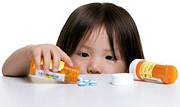The Overmedicated Child
By Dr. Claudia Anrig
Are prescription drugs safe for children? With their bodies going through rapid developmental changes, how does the medical community know the proper prescriptions and dosage? Find out the unique dangers children face and how parents can help.
Harry Shirkey, a medical practitioner, coined the term "therapeutic orphans" more than 40 years ago to describe how children are overlooked in medical research. His observations remain true today. Despite the best efforts of the American Academy of Pediatrics (AAP) and the Federal Drug Administration (FDA), nothing has really changed.
Guesstimating Medicine
The majority of drugs given to children have never been tested specifically for them. Physicians are prescribing drugs based on a "best guess" as to the dosage, efficacy and even safety. It's becoming clearer to federal regulators and physicians alike that children are not just "small adults." With their bodies in different stages of development, they process medication differently; sometimes faster, sometimes slower and sometimes turning it into poison. Their body chemistry has not fully matured and yet adult drugs are being prescribed to children on a regular basis. Dr. Joseph M. Wiley, chief of pediatrics at Sinai Hospital in Baltimore, has said, "If you extrapolate from an adult dose to a pediatric dose, you may be right ... you may be wrong."
The Path to Pediatric Testing
 The road to pediatric drug testing has been a rocky one. Nobody wants to use children as guinea pigs, but the problem remains that drugs are being given to children in potentially unsafe doses.
The road to pediatric drug testing has been a rocky one. Nobody wants to use children as guinea pigs, but the problem remains that drugs are being given to children in potentially unsafe doses.
The FDA understands that giving medications to children for which there is only adult data available could be harmful, considering that children have dosing concerns and side-effect risks that differ from adults. The latest legislation has made some headway in the battle against the lack of proper labeling, yet it still fails to completely overcome the absence of research, particularly in the older medications.
This year, the Government Accountability Office said that only one-third of the drugs prescribed for children have been studied and labeled for pediatric use. The pediatric research that has been done includes some frightening results: Of the older drugs just recently being studied in children, 87 percent were being improperly prescribed. Children were getting medicine that didn't work at all, was under- or overdosed, or that had some possibly deadly side effects.
Dr. Dianne Murphy of the FDA's Office of Pediatric Therapeutics had this to say: "We found out that you can't predict how kids are going to handle things." The problem is that once a medication has been approved for use in adults, it legally can be prescribed to anyone for any reason, despite the lack of pediatric testing or proper labeling.
Off-Label Prescribing
The most recent research lists the following top 10 drugs being prescribed to children without proper labeling: Albuterol, Phenergan, Ampicillin, Auralgan, Lotison, Prozac, Intal, Zoloft, Ritalin and alupent syrup. This common practice of prescribing medicine to children that has only been tested and labeled for adult use is called "off-label prescribing" and it's done by physicians every day. A recent study published in the Archives of Pediatrics and Adolescent Medicine showed that off-label drugs were used in nearly 80 percent of major children's hospitals in 2004.

